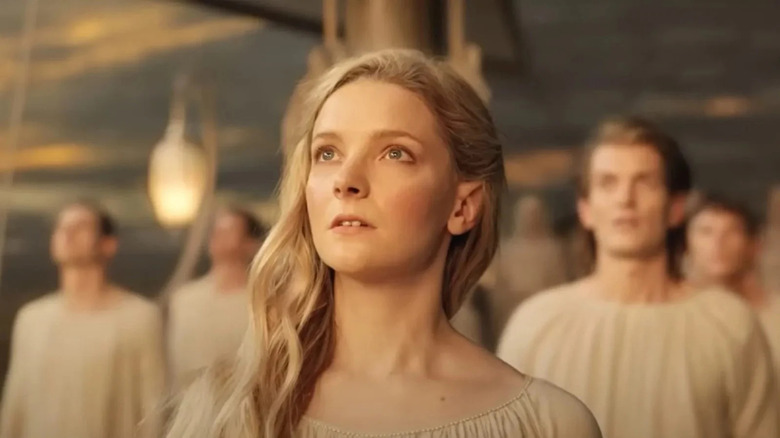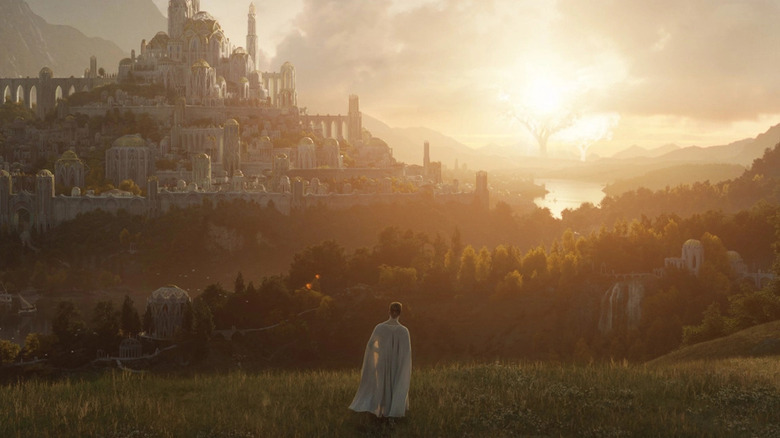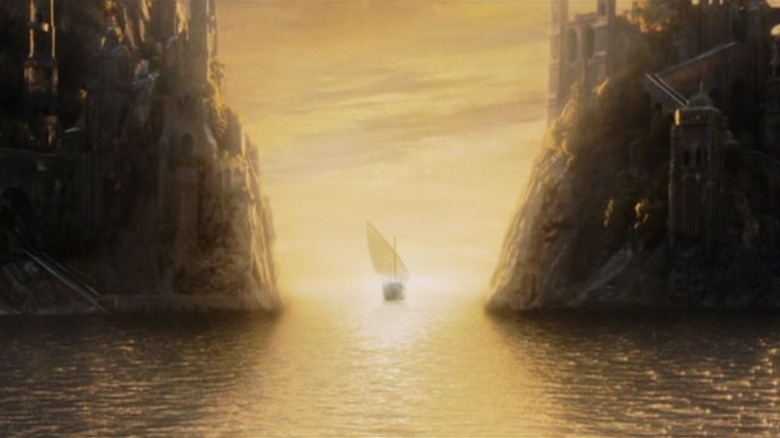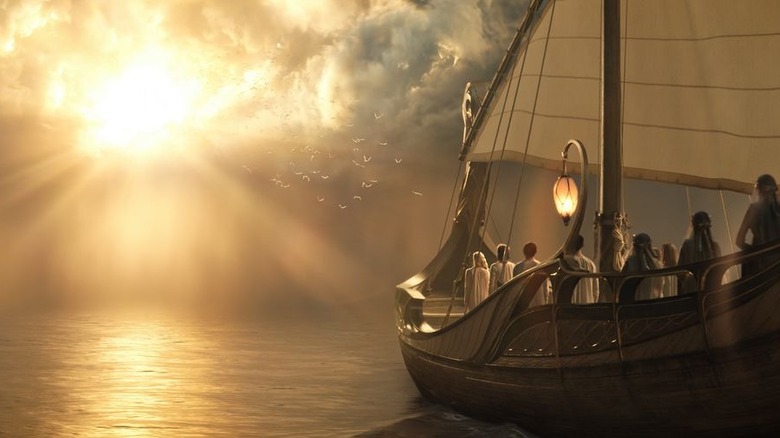The Lord Of The Rings' Valinor Explained: How The Blessed Realm Differs In The Books, Peter Jackson's Films, And The Rings Of Power
The lore of J.R.R. Tolkien's Middle-earth is vast and sometimes confusing. There's over 9,000 years worth of intricate history that film and television has not even touched on. For those who have been watching Amazon's "The Lord of the Rings: The Rings of Power," it's been exciting to explore new corners of Middle-earth and the early lives of beloved characters like Galadriel (Morfydd Clark). One of the key places that we are introduced to in the first episodes of the series is Valinor, also known as the Undying Lands. It is a tranquil, sprawling land where Galadriel grew up that she describes as a "winterless spring."
In "The Return of the King" novel, Tolkien depicts Frodo's experience in Valinor:
"Frodo smelled a sweet fragrance on the air and heard the sound of singing that came over the water ... the grey rain-curtain turned all to silver glass and was rolled back, and he beheld white shores and beyond them a far green country under a swift sunrise."
This language is eventually used in Peter Jackson's film version during the song "Into the West." Both Peter Jackson in "The Lord of the Rings" trilogy and the "The Rings of Power" creators reflect Valinor's immaculate beauty in their cinematography of shining, golden hues. Valinor is a mix between Mount Olympus and the Garden of Eden, the home of Middle-earth's godlike beings and the immortal elves. The common misconception is that Valinor is a kind of heaven for everyone in Middle-earth but only elves and a select few are permitted to spend the rest of their lives there. It is a paradise with no pain or suffering. Galadriel has a different relationship with Valinor in all versions of Middle-earth tales.
The history of Tolkien's Valinor
In the books, Valinor exists on the continent of Aman, west of Middle-earth across the great ocean known as the Sundering Seas. Before, the ocean was a bridge of ice called the Helcaraxë which Galadriel walked across during the Exile of the Noldor in the First Age, when a group of elves went to defeat Morgoth in Middle-earth after he destroyed the Two Trees of Valinor. We see these trees in "The Rings of Power," beautiful sources of light created by the Valar in ancient times. Their last flower and fruit was transformed into the sun and the moon. The rebellious Noldor are banned from returning to Valinor by the Valar.
In the Second Age, the Valar destroy passage to Aman after the men of Numenor attempt to invade Valinor to achieve immortality for the human race. The Valar take Valinor out of Aman and place it above the surface of the earth where you must follow The Straight Path "into the realm of hidden things, a mighty bridge invisible that passed through the air of breath and of flight (which were bent now as the world was bent)," Tolkien writes in "The Silmarillion."
After the War of Wrath ends, the Valar pardon Galadriel and the other elves and allow them to return to Valinor but Galadriel refuses because she has a fierce desire to rule over her own kingdom. That is what motivated her to travel to Middle-earth more than overthrowing Morgoth. She remains in Middle-earth for two more ages to satisfy her craving for power.
Valinor in Peter Jackson's films
Our main glimpse of Valinor in Peter Jackson's "The Lord of the Rings" trilogy is during the deeply emotional ending of "The Return of the King." Frodo travels to the Undying Lands with Bilbo, Gandalf, Elrond, Galadriel, and Celeborn. In the books, Sam, Legolas, and Gimli eventually go as well.
While the Undying Lands are for the elves, Frodo is invited so that he can heal from the immense damage the Ring did to his soul. Middle-earth could not save him from Sauron's corruption and his painful suffering. He and Bilbo are rewarded for keeping the ring safe and are able to live the remainder of their days in serenity. Peter Jackson masterfully crafts this scene as a combination of heart-wrenching melancholy (I sob every time he says goodbye to the hobbits) and happiness that Frodo will finally be at peace.
The trilogy also references Galadriel's complicated relationship with Valinor. She has clusters of star-like lights in her deep blue eyes because she is the last to have seen the light of the Two Trees. After she resists taking the One Ring when Frodo offers it to her, she references passing a "test" and is now able to "diminish and go into the West." In other words, the Valar will let her return to the Undying Lands. Tolkien explains why Galadriel's ban is lifted in the book "The Letters of J.R.R. Tolkien":
"She was pardoned because of her resistance to the final and overwhelming temptation to take the ring for herself."
We see Galadriel at the end of "The Lord of the Rings: The Return of the King" at the ship heading to Valinor because she has given up her lust for power for the greater good.
What The Rings of Power changes about Valinor
In the climactic moments of the first episode of "The Rings of Power," Galadriel must choose between joining the other elves in Valinor, her beloved former home, or pursue Sauron in Middle-earth. In a heroic and lengthy sequence during the second episode, Galadriel turns back to complete her mission.
One of the biggest departures from Tolkien's writing is that Galadriel is not banned from Valinor by the Valar. Instead, the High King of the elves Gil-galad allows Galadriel and her fellow warriors to travel to the Undying Lands. He doles out Valinor like a prize, not a deeply personal decision and something each elf can choose for themselves. The show treats Valinor like something that can be handed out by a ruler based on his own whims, completely erasing the will of the supreme Valar.
This completely changes the structure of leadership in Tolkien's world, but perhaps "The Rings of Power" thought it was easier to depict it this way rather than delve even more into the dense mythology. By removing the Valar's ban, Galadriel is torn between two separate worlds that she cares about deeply due to her need to avenge her brother Finrod. This makes for higher stakes, more dramatic tension, and an exciting narrative.
What "The Rings of Power" does get across, like Peter Jackson's films, is that Valinor is a special, even holy place that promises comfort for characters, but only when they are truly ready to go there.



